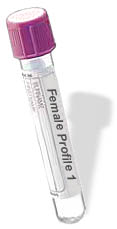 Reasons to take this test: If you are suffering from PMS, Endometriosis, Uterine Fibroids or Menopause or Perimenopause, or you have hot flashes, night sweats, sleeplessness, fatigue, mood swings, irritability, depression, mental fogginess, memory loss, vaginal dryness, weight gain, wrinkles, thinning skin, thinning bones, or you want to prevent breast, ovarian, or uterine cancer, then you should get your your hormone tested every year and keep them balanced .
Reasons to take this test: If you are suffering from PMS, Endometriosis, Uterine Fibroids or Menopause or Perimenopause, or you have hot flashes, night sweats, sleeplessness, fatigue, mood swings, irritability, depression, mental fogginess, memory loss, vaginal dryness, weight gain, wrinkles, thinning skin, thinning bones, or you want to prevent breast, ovarian, or uterine cancer, then you should get your your hormone tested every year and keep them balanced .
Overview Hormones exert a powerful influence over a woman’s health. Estrogens protect a woman from cardiovascular disease and osteoporosis and are vital for fertility. Progesterone levels affect mood, and balance the tissue proliferative effect of Estrogen. Testosterone increases energy, libido, and muscle.
An assessment of your hormonal balance can be made by measuring 6 key hormones:
- Estrone (E1)
- Estradiol (E2)
- Estriol (E3)
- Progesterone
- Testosterone
- DHEA
Informed decisions regarding the need to initiate Bio-Identical Hormone Replacement Therapy (BHRT), or how to individualize therapy can then be made to maximize the health benefits of hormone therapy. Individual differences in hormone metabolism make monitored therapy the best choice for long term health and prevention of cancer.
Careful monitoring and individualization of BHRT can provide women with the benefits of supplemented Estriol while reducing the risk of uterine, ovasrian and breast cancer. (An increased cancer risk has been associated with synthetic HRT. This is not the case with natural BHRT use.)
Estrogens: The ovaries produce three different Estrogens, Progesterone and Testosterone from cholesterol, which is produced in the liver.
Many women do not know that Testosterone is produced by both men and women. The steroid hormone Dehydroepiandrosterone (DHEA) is converted in both men and women to Testosterone first, then Testosterone is converted into Estradiol(E2), the major Estrogen secreted by the human ovary.
Two other Estrogens are also produced in women. The next most potent Estrogen is Estrone (E1).
The third Estrogen, Estriol (E3), is synthesized outside the ovary in the peripheral tissues of the body from Estrone and Estradiol. Estriol has been shown to be protective against Breast Cancer. Low levels of Estriol place you at an increased risk for developing cancer.
You should check all of your Estrogen levels periodically to make sure that they are in a health balance approximately equal to a ratio of at least 8:1:1, Estriol to Estrone to Estradiol, respectively.
With advancing age, a woman’s ovarian function declines, leading to a decline in the production of Estrogen. This decline leads to vasomotor instability that causes hot flashes. It also causes decreased muscle mass, which is then replaced by fibrous tissue. Thinning skin and wrinkles are due to a loss of collagen and elastin that leads to many of the unwanted signs of aging.
Vaginal mucous membranes also become thin and dry and breast tissue begins to sag. Supplementing natural Estrogen replacement can help stop many of these undesirable effects associated with menopause.
Progesterone: Progesterone is also produced by the ovaries from cholesterol. It has its own unique hormonal functions, but a certain amount is also converted into Estrogen. Progesterone increases uterine secretions and stimulates calcium deposits into bone tissue. It also helps regulate salt, control blood sugar, modulate nerve function and promote a healthy thymus gland. Most importantly, Progesterone stimulates bone building, cancer suppression as well as the activation of GABA, the calming neurohormone. Supplementing natural Progesterone can help maintain these healthy functions and benefits.
Testosterone: Women need and produce a small amount of Testosterone everyday. Testosterone is a natural anti-depressant that boosts your mood and energy. It increases energy and sex drive, maintains health muscle mass and protects the heart. However, as a woman’s ovarian function declines in the years before and during natural menopause, so does the amount of Testosterone she produces. Between a woman’s 20s and 40s the amount of Testosterone circulating in her blood declines about 50%.
If a woman starts Estrogen Only Replacement Therapy at menopause, her blood levels of Testosterone drop even further due to a biochemical reaction. Symptoms such as fatigue, muscle wasting, low sex drive, decreased sexual stimulation, and diminished sense of well-being can be due to a Testosterone deficiency. These symptoms may be significantly improved with natural Testosterone replacement.
DHEA: Dehydroepiandrosterone (DHEA) is the most abundant steroid in the body. DHEA is a steroid precursor produced by the adrenal gland and converted to Testosterone and the Estrogens. DHEA levels decrease dramatically with age. Adequate DHEA levels give the body the building blocks necessary to produce these hormones. Low levels of DHEA are associated with and increase in coronary artery disease, muscle wasting and osteoporosis. Taking DHEA reverses these processes and may also increase the sense of well-being.
Hormone levels affect health and well-being. Monitoring hormone therapy increases therapy benefits while reducing side effects. Due to individual differences in hormone absorption and metabolism, the hormone dosage required to attain physiologic levels will vary by patient and method of administration.
Summary : Long term use of a correctly balanced Bi0-Identical Hormones has been found to significantly slow the onset of the signs of aging and lower the risk of cancer. Health risks are significantly reduced with carefully monitored customized treatment.
References
- Samsioe G. The endometrium: effects of estrogen and estrogen-progestogen replacement therapy. Int J Fertil Menopausal Stud 1994;39 Suppl 2:84-92
- Davis S. Androgen replacement in women: a commentary. J Clin Endocrinol Metab 1999 Jun;84(6):1886-91
- Watts NB. Hulka BS. Epidemilogical analysis of breast and gynecological cancers. Prog Clin Biol Res. 1997;396:17-29.
- Rosano GM, Panina G. Cardiovascular pharmacology of hormone replacement therapy. Drugs Aging 1999 Sep;15(3):219-34

